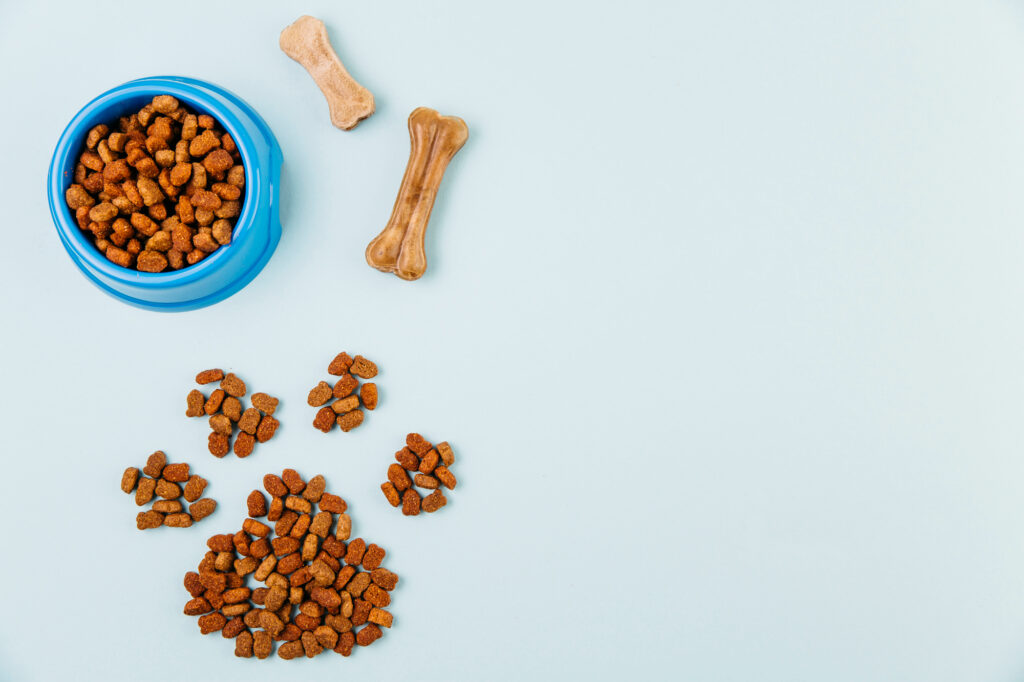
Choosing the right food for your furry friend can feel overwhelming. With aisles stacked with kibble (dry dog food) brands promising everything from shiny coats to superhero strength, it’s hard to know where to begin. This guide will help you navigate the world of best dry dog food in 2024, exploring the benefits and potential risks, and ultimately, helping you pick the best kibble for your beloved pup!
Also Read: Vet-Approved Homemade Dog Food Recipes for Kidney Disease: An Ultimate Guide
Understanding Your Dog’s Needs:
Before diving into brands and ingredients, let’s talk about your dog! Just like humans, dogs have different dietary needs depending on their age, activity level, and any health concerns. Here are some factors to consider:
- Age: Puppies need different nutrients than adult dogs, and senior canines might require specialized formulas for joint health or digestion.
- Activity Level: Highly active dogs like working breeds or sporting companions burn more calories and need a higher-protein kibble to fuel their adventures. Less active pups might do well with a lower-calorie formula to avoid weight gain.
- Health Concerns: If your dog has any allergies, sensitivities, or specific health conditions, look for a kibble formulated to address those needs. Always consult your veterinarian for personalized recommendations.

Benefits of Dry Dog Food:
Kibble offers several advantages for both you and your dog:
- Convenience: Dry dog food is easy to store, portion control, and travel with. It also doesn’t require refrigeration, making it a practical choice for busy schedules.
- Dental Health: Crunching on kibble can help clean your dog’s teeth and remove plaque, promoting good oral health.
- Balanced Nutrition: High-quality dry dog food is formulated to provide all the essential nutrients your dog needs to stay healthy and active. They are typically fortified with vitamins, minerals, and essential fatty acids for a complete and balanced diet.
- Portion Control: Dry food allows you to easily measure and control your dog’s portions, which is important for maintaining a healthy weight.
Also Read: Puppy Kisses… or a Medical Mystery? 10 Reasons Why Dogs Lick Excessively
Potential Risks and Concerns of Kibble:
While convenient, kibble isn’t without its drawbacks:
- Lower Moisture Content: Compared to wet food, dry dog food has a lower moisture content. This might not be ideal for all dogs, especially those prone to urinary tract issues. Make sure your dog has access to plenty of fresh water to compensate.
- Carbohydrate Content: Some dry dog food formulas are high in carbohydrates, which can contribute to weight gain or digestive issues in some dogs.
- Artificial Ingredients: Some brands might use artificial colors, flavors, or preservatives. Look for kibble made with natural ingredients and whole foods whenever possible.

What to Look For?
Now that you understand your dog’s needs and the pros and cons of dry food, let’s explore what to look for on those kibble bags:
- Ingredients: Look for a kibble formulated with whole foods like real meat, poultry, or fish as the first ingredient. Avoid kibble with a long list of unrecognizable ingredients or fillers like corn, wheat, or soy.
Also Read: 07 Tips for Personalized Pet Nutrition Plans: Fueling Your Pet’s Best Life
- Protein Content: The protein content in kibble varies depending on your dog’s needs. Generally, puppies and active dogs need higher protein levels (25-35%), while adult dogs with moderate activity levels might do well with 18-25% protein. Discuss your dog’s specific needs with your veterinarian.
- AAFCO Statement: Look for the AAFCO (Association of American Feed Control Officials) statement on the bag. This ensures the food meets the nutritional requirements for your dog’s life stage.
- Guaranteed Analysis: The guaranteed analysis section on the label lists the minimum and maximum percentages of protein, fat, fiber, and moisture in the food. This can help you compare different brands and choose one that best meets your dog’s needs.
Popular Dry Dog Food Brands in 2024 ([Disclaimer: Please note that these are just a few examples, and it’s important to do your own research to find the best food for your dog]):
There are many fantastic dry dog food brands available, but here are a few popular choices in 2024, categorized by their focus:
- High-Quality Ingredients: Open Farm, Nature’s Logic, Merrick Purrfect Bistro Dry Dog Food
- Grain-Free: Blue Buffalo Wilderness, Taste of the Wild, Castor & Pollux Organix
- Puppy Formulas: Purina Pro Plan FOCUS Puppy Formula, Hill’s Science Diet Puppy Healthy Development Small Bites, Royal Canin Puppy Dry
Choosing the Right Kibble:
Beyond the Bag (Remember, this is not a substitute for professional veterinary advice)
While the bag itself holds valuable information, choosing the right kibble goes beyond just reading the label. Here are some additional factors to consider:
- Online Reviews and Research: Read online reviews from other dog owners and research the brand’s reputation. Look for companies with transparent practices and a commitment to using high-quality ingredients.
- Feeding Trials: Once you’ve chosen a dry dog food, consider a feeding trial before making a permanent switch. Start by gradually introducing the new kibble alongside your dog’s current food, slowly increasing the new food’s proportion over a week or two. Monitor your dog’s digestion, energy levels, and stool quality during the transition.
- Veterinarian Consultation: Always discuss your dog’s diet with your veterinarian. They can recommend specific brands or formulas based on your dog’s age, breed, health, and activity level. A vet visit is crucial if your dog has any allergies, sensitivities, or pre-existing health conditions.

Also Read: 05 Homemade Dog Food Recipes for Skin Allergies: Itchy Relief for Your Furry Friend!
Beyond Kibble: Exploring Alternative Diets
Dry dog food isn’t the only option! Here’s a quick look at some alternative diets:
- Wet Food: Wet food offers a higher moisture content and can be a good choice for dogs with sensitive stomachs or urinary tract issues. However, wet food can be more expensive and requires more frequent cleaning of food bowls.
- Raw Food Diets: Raw food diets involve feeding your dog uncooked meat, vegetables, and other ingredients. While raw food diets can be beneficial, they require careful planning and preparation to ensure your dog receives all the necessary nutrients. It’s important to discuss this option with your veterinarian before starting your dog on a raw food diet.
- Homemade Diets: Homemade dog food offers complete control over ingredients, but it requires significant research and effort to ensure a balanced and complete diet. Consult a veterinary nutritionist for guidance before creating a homemade diet for your dog.
Also Read:
The Bottom Bowl: Choosing the Perfect Food for Your Pup
There’s no single “best” dry dog food in 2024. The ideal kibble for your furry friend depends on their individual needs, preferences, and any health considerations. By understanding your dog’s specific requirements, carefully reading labels, and consulting with your veterinarian, you can choose a high-quality dry dog food that fuels their health, happiness, and those playful zoomies!
Remember:
- A healthy diet is a cornerstone of your dog’s well-being. Choose a kibble that provides them with the essential nutrients they need to thrive.
- Don’t be afraid to experiment and find the right food for your dog. Just make sure to introduce any new food gradually to avoid digestive upset.
- When in doubt, always consult your veterinarian for personalized advice on choosing the best diet for your beloved canine companion.
Happy Feeding!
What is the Best Dry Dog Food in 2024? – FAQs
There isn’t a single “best” dry dog food for all pups! The ideal kibble depends on your dog’s unique needs, age, and health. However, this FAQ can help you navigate your options and choose a high-quality food for your furry friend:
Q. What factors should I consider when choosing a dry dog food?
Several factors influence the best dry dog food for your pup:
- Age: Puppies need different nutrients than adult dogs, and seniors might require specialized formulas for joint health or digestion.
- Activity Level: Highly active dogs burn more calories and need a higher-protein kibble. Less active pups might do well with a lower-calorie formula.
- Health Concerns: Look for a kibble formulated for allergies, sensitivities, or specific health conditions your dog might have. Consult your veterinarian for personalized recommendations.
- Ingredients: Choose a kibble with whole foods like real meat, poultry, or fish as the first ingredient. Avoid kibble with fillers like corn, wheat, or soy.
Q. What’s the deal with grain-free dog food?
Grain-free dog food has become popular, but it’s not necessarily better for all dogs. Grain-free formulas can be a good option for pups with grain sensitivities, but some might lack essential nutrients found in whole grains.
- Consult Your Veterinarian: Discuss your dog’s specific needs with your vet before switching to a grain-free diet.
- Focus on Ingredients: Look for grain-free kibble that replaces grains with other healthy ingredients like vegetables or legumes, ensuring a balanced nutrient profile.
Q. Are expensive dog foods always better?
Price doesn’t always guarantee quality. However, some high-quality ingredients used in premium dog foods can be more expensive.
- Focus on Ingredients: The most expensive kibble might not be the best choice. Read the label and prioritize whole foods, balanced nutrition, and ingredients that meet your dog’s needs.
- Research and Compare: Do your research and compare different brands within your budget. You might find a fantastic dry dog food that offers excellent quality at a reasonable price point.
Q. What are some signs my dog might not be happy with their current food?
Several signs might indicate your dog isn’t a fan of their current kibble:
- Picky Eating: If your dog consistently leaves kibble uneaten or shows little enthusiasm for mealtime, it might be a sign they don’t find the food palatable.
- Digestive Issues: Kibble that doesn’t agree with your dog can cause gas, bloating, or diarrhea.
- Skin and Coat Issues: Poor-quality ingredients or a lack of essential nutrients can lead to dull fur, excessive shedding, or skin problems.
Q. Is it okay to mix dry food with wet food?
Absolutely! Mixing dry food with wet food can add moisture and variety to your dog’s diet. Just make sure to adjust the portion sizes to avoid overfeeding.
- Choose Compatible Brands: If mixing kibble and wet food, opt for products from the same brand to ensure they complement each other nutritionally.
- Consult Your Veterinarian: Discuss this option with your vet, especially if your dog has any health concerns or needs a specific dietary plan.
Q. How can I transition my dog to a new dry dog food?
Introducing a new food too quickly can cause digestive upset. Always transition your dog to a new kibble gradually:
- Start Slowly: Over a period of 7-10 days, slowly mix increasing amounts of the new kibble with their current food, gradually decreasing the old food each day.
- Monitor Digestion: Pay attention to your dog’s stool quality and overall well-being during the transition. If you notice any digestive issues, slow down the process or consult your veterinarian.
Q. What online resources can help me research dry dog food brands?
Several online resources can help you research different dry dog food brands:
- Review Websites: Websites like [Dog Food Advisor](URL dog food advisor website) and [Rover](URL dog food ratings ON Rover.com) offer reviews and comparisons of various dry dog food brands.
- Brand Websites: Most dog food brands have websites with detailed information about their products, ingredients, and feeding recommendations.
- Veterinarian Websites: The websites of veterinary organizations like the [American Veterinary Medical Association](URL american veterinary association ON American Veterinary Medical Association avma.org) offer resources and information on canine nutrition.
Q. Is it okay to give my dog human food scraps?
While occasional table scraps might seem harmless, it’s important to be mindful:
- Toxic Foods: Certain human foods are toxic to dogs, like chocolate, grapes, and onions. Do your research and avoid giving your dog anything that could be harmful.
- Unbalanced Diet: Human food isn’t formulated for dogs and might lack essential nutrients they need. Table scraps shouldn’t replace a balanced dog diet.
- Weight Gain: Human food can be high in calories and fat, leading to weight gain in dogs. Consult your veterinarian before offering frequent table scraps.
Q. I’m overwhelmed by all the choices! How can I find the best dry food for my dog?
Don’t worry, you’re not alone! Choosing the right dry dog food can feel confusing. Here are some steps to simplify the process:
- Talk to Your Veterinarian: Discuss your dog’s age, breed, activity level, and any health concerns with your vet. They can offer personalized recommendations for the best type of dry dog food for your pup.
- Consider Your Budget: High-quality dry dog food can be expensive, but there are fantastic options available at various price points. Focus on finding a kibble that offers good value for your money and meets your dog’s needs.
- Read Labels Carefully: Don’t be afraid to research different brands and compare ingredients lists. Look for whole foods, balanced nutrition, and an AAFCO statement on the label.
- Start Small and Monitor: Choose a dry dog food based on your research and veterinarian’s recommendations. Start with a small bag and monitor your dog’s health and well-being during the feeding trial.

